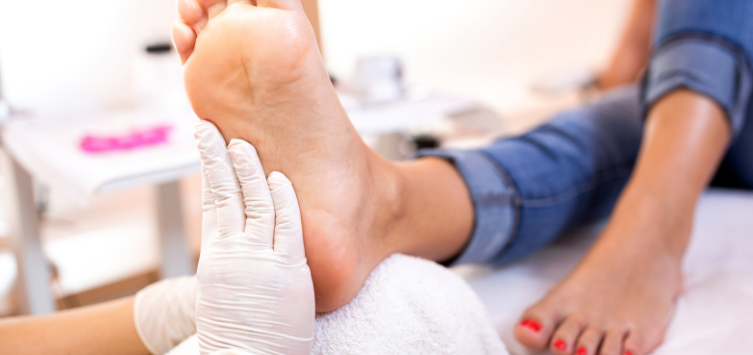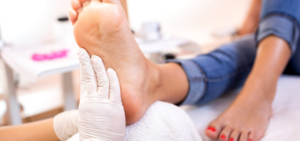


By Nancy Morgan, RN, BSN, MBA, WOCN
Each month Nancy Morgan Wound Care brings you a tool you can apply in your daily practice
Support Resources:
Infographics: Foot Care Infographic
Description

As a foot care specialist, I understand the importance of performing a thorough and accurate foot assessment in order to identify and treat any problems that may be present. A proper foot assessment involves several key steps, including inspection, palpation, and range of motion testing.
The first step in a foot assessment is inspection.
The foot care specialist will look at the patient’s feet and lower legs, noting any abnormalities such as redness, swelling, blisters, calluses, or other changes in the skin. The toenails will also be inspected for signs of ingrown nails or fungal infections. The footwear will also be inspected for the proper fit, support and the condition of the shoe.
Next, the foot care specialist will perform palpation
which involves feeling for any tenderness or masses in the feet and lower legs. This is done using the hands to feel for any abnormalities that may not be visible during inspection.
Test Patient’s Range of Motion
The foot care specialist will then test the patient’s range of motion, which involves moving the patient’s joints to see how well they are working. The patient will be asked to move their toes and feet in different directions and the foot care specialist will observe the range of motion and any pain or discomfort that may be present.
Assess Patient’s Sensation
Finally, the foot care specialist will assess the patient’s sensation, which includes the ability to feel touch, temperature and vibration. This can be done by using a monofilament and/or a tuning fork.
Medical History, Medication and other relevant information
The foot care specialist will also take into consideration any medical history, current medication, and any other relevant information that may be related to the patient’s foot and lower leg health.
In summary, a proper foot assessment is a crucial step in identifying and treating any problems that may be present. It involves several key steps, including inspection, palpation, range of motion testing, and sensation assessment. The foot care specialist will also take into consideration any medical history, current medication, and any other relevant information that may be related to the patient’s foot and lower leg health. It’s important to work closely with a healthcare provider to develop an individualized foot care plan that addresses the unique needs of each patient.
Nancy Morgan RN, BSN, MBA, WOCN is an experienced clinician, successful business leader, and accomplished nurse educator in the field of wound management. She is the co-founder of the Wound Care Education Institute, (WCEI®), Wild on Wounds Productions; and, most recently established Nancy Morgan Wound Care offering innovative, educational resources including wound measurement seminars, webinars, social media and wound care marketing tools to assist and support wound care clinicians at the bedside. Nancy is one of the most distinguished wound care educators, delivering nearly 1200 lectures, conference keynote addresses, seminars, webinars, and bedside consultations during her career.
Information is courtesy of Nancy Morgan Wound Care, copyright 2022.